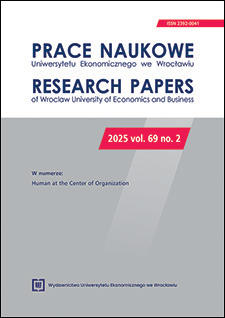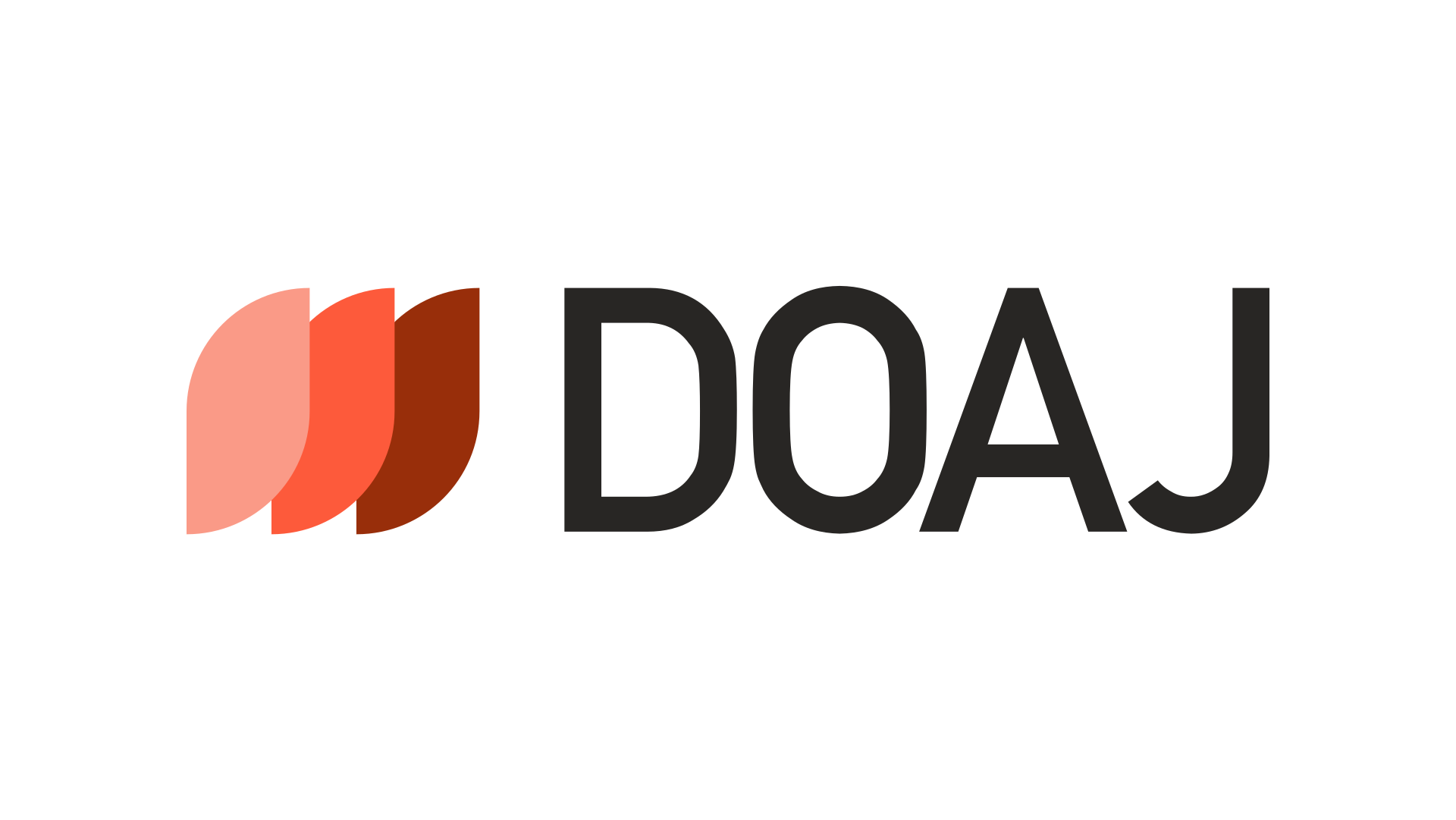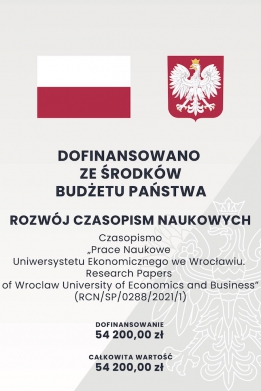The Effects of Employee Retention on Company Performance Results: the Mediating Role of HRM Outcomes in Central European Headquarters of MNCs
DOI:
https://doi.org/10.15611/pn.2025.2.05Keywords:
employee retention, HRM, company performance, efficiency, MNCsAbstract
Aim: The main goal of the article was to determine the mediating role of HRM outcomes in the relationships between employee retention (ER) and company performance results (CPR), and to establish the existence of any identifiable regularities in this scope in the pre-pandemic and pandemic period of COVID-19 (understood as a crisis condition) in the headquarters (HQs) of multinational companies (MNCs).
Methodology: The empirical research was conducted in 200 MNCs with headquarters in Central Europe. To accurately reflect the relationships among the studied variables, the raw data were modified using the Efficiency Index (EI). The research hypotheses were tested and the mediating effects evaluated using Partial Least Squares Structural Equation Modeling (PLS-SEM).
Results: The study results indicate that HRM outcomes give a positive effect as a mediator between employee retention and company performance results in crisis. It shows statistically significant relations between business strategies, ER practices and companies performance results which can be useful for academic discourse and business decisions to plan the role of HRM for future crises.
Implications and recommendations: The author’s own research revealed the mediation of HRM outcomes between ER and company performance results in finance, innovativeness, and quality. Thereby, this study has become another voice in the discussion on HRM strategies and policies for crisis taking into account four types of companies’ performance results.
Originality/value: The research findings are not only of an innovative character due to MNCs being headquartered in Central Europe, but also because they link ER with companies results by using HRM outcomes and show its role in their performance and resilience in crisis.Downloads
References
Adikaram, A. S., Naotunna, N., & Priyankara, H. P. R. (2021). Battling COVID-19 with Human Resource Management Bundling. Employee Relations: The International Journal, 43(6), 1269-1289.
Aguinis, H., & Kraiger, K. (2009). Benefits of Training and Development for Individuals and Teams, Organizations, and Society. Annual Review of Psychology, 60(1), 451-474.
Akhtar, S., Ding, D. Z., & Ge, G. L. (2008). Strategic HRM Practices and Their Impact on Company Performance in Chinese Enterprises. Human Resource Management, 47, 15-32. https://doi.org/10.1002/hrm.20195
Alhmoud, A., & Rjoub, H. (2019). Total Rewards and Employee Retention in a Middle Eastern Context. SAGE Open, 9(2). https://doi.org/10.1177/2158244019840118
Ansari, K. R., & Bijalwan, P. (2017). Team Effectiveness: A Relational Approach with Employee Retention. Metamorphosis 16(2), 115-121.
Böhmer, N., & Schinnenburg, H. (2023). Critical Exploration of AI-driven HRM to Build Up Organizational Capabilities. Employee Relations, 45(5), 1057-1082. https://doi.org/10.1108/ER-04-2022-0202
Brewster, C. (2007). European Perspective on HRM. European Journal of International Management, 1(3), 014696.
Brewster, C., Houldsworth, E., Sparrow, P., & Vernon, G. (2023). International Human Resource Management, 5th edition. Kogan Page.
Brewster, C., Morley, M., & Bučiūnienė, I. (2010). The Reality of Human Resource Management in Central and Eastern Europe: A Special Issue to Mark the 20th Anniversary of Cranet (the Cranfield Network on Comparative Human Resource Management). Baltic Journal of Management, 5(2), 145-155. https://doi.org/10.1108/17465261011045098
Brewster, C., Wood, G., & Brookes, M. (2008). Similarity, Isomorphism or Duality? Recent Survey Evidence on the Human Resource Management Policies of Multinational Corporations. British Journal of Management, 19, 320-342. https://doi.org/10.1111/j.1467-8551.2007.00546.x
Brunet-Thornton, R. (2017). Foreword to the Special Edition, the Return to Europe: A Generation of Re-Inventing National Identities. Baltic Journal of Management, 12(1), 2. https://doi.org/10.1108/BJM-10-2016-0239
Cascio, W. F., Boudreau J. W., & Fink, A. A. (2019). Investing in People: Financial Impact of Human Resource Initiatives. Society for Human Resource Management.
Choi, M., & Yoon, H. J. (2015). Training Investment and Organizational Outcomes: A Moderated Mediation Model of Employee Outcomes and Strategic Orientation of the HR Function. The International Journal of Human Resource Management, 26(20), 2632-2651. https://doi.org/10.1080/09585192.2014.1003084
Chopra, A., Sahoo, C. K., & Patel, G. (2023). Exploring the Relationship between Employer Branding and Talent Retention: The Mediation Effect of Employee Engagement. International Journal of Organizational Analysis, 32(4). https://doi.org/10.1108/IJOA-02-2023-3638
Chouhan, V. S., (2023). Impact of Career Adaptability on Employee Performance: The Moderating Role of HR Practices. Management and Labour Studies, 48(3), 325-342.
Cooke, F. L., Veen, A., & Wood, G. (2017). What Do We Know about Cross-Country Comparative Studies in HRM? A Critical Review of Literature in the Period of 2000-2014. The International Journal of Human Resource Management, 28(1), 196-233.
Czakon, W. (2020). Krótkowzroczność strategiczna menedżerów. Wydawnictwo Uniwersytetu Jagiellońskiego.
De Clercq, D., Haq, I. U., & Azeem, M. U. (2023). Unfair Rewards, Poorly Performing Organizations and Perceptions of Deservingness as Explanations of Diminished Job Performance. Journal of Organizational Effectiveness: People and Performance, 10(4), 624-643. https://doi.org/10.1108/JOEPP-11-2022-0315
Dickmann, M., Brewster, C., & Sparrow, P. (Eds.). (2016). International Human Resource Management. Contemporary HR Issues in Europe. Taylor & Francis.
Dowling, P. J., Festing, M., & Engle, A. D., (2017). International Human Resource Management: Managing People in a Multinational Context. Cengage India.
Ganguli, R., & Padhy, S. C. (2023). Moderating Effect of Demographic Factors on the Relationship Between Work Motivation and Employee Retention of Gen Z. NMIMS Management Review, 31(2), 145-156.
Garavan, T., McCarthy, A., Lai, Y., Murphy, K., Sheehan, M., & Carbery, R. (2021). Training and Organisational Performance: A Meta-Analysis of Temporal, Institutional and Organisational Context Moderators. Human Resource Management Journal, 31(1), 93-119. https://doi.org/10.1111/1748-8583.12284
Garengo, P., Sardi, A., & Nudurupati, S. S. (2022). Human Resource Management (HRM) in the Performance Measurement and Management (PMM) Domain: A Bibliometric Review. International Journal of Productivity and Performance Management, 71(7), 3056-3077. https://doi.org/10.1108/IJPPM-04-2020-0177
Hair, J. F., Sarstedt, M., Ringle, C. M., & Gudergan, S. P. (2023). Advanced Issues in Partial Least Squares Structural Equation Modeling. SAGE Publications.
Haromszeki, Ł. (2010). Przywództwo w czasie kryzysu. In T. Listwan, (Ed.), Zarządzanie w sytuacjach kryzysowych podczas Euro 2012. Wydawnictwo Uniwersytetu Ekonomicznego we Wrocławiu.
Haromszeki, Ł. (2023a). Differences in the Approach to Onboarding Leadership Talents in the HQ of MNCs Before and During the Covid-19 Pandemic. Organizacja i Kierowanie, 1, 41-56.
Haromszeki, Ł. (2023b). Kształtowanie kultury organizacyjnej zorientowanej na zarządzanie talentami przywódczymi w polskich firmach międzynarodowych przed pandemią i w jej trakcie. Zarządzanie Zasobami Ludzkimi, 150, 42-58. https://doi.org/10.5604/01.3001.0016.2924
Haromszeki, Ł. (2024). Effects of Leadership Talent Management on the Company Performance Results. Scientific Papers of Silesian University of Technology. Organization and Management Series, 191, 195-215, https://doi.org/10.29119/1641-3466.2024.191.13
Huselid, M. A. (1995). The Impact of Human Resource Management Practices on Turnover Productivity and Corporate Financial Performance. Academy of Management Journal, 38(3).
Hyder, A. S., & Abraha, D. (2008). Institutional Factors and Strategic Alliances in Eastern and Central Europe. Baltic Journal of Management, 3(3), 289-308.
Jacobs, R., & Washington, C. (2003). Employee Development and Organizational Performance: A Review of Literature and Directions for Future Research. Human Resource Development International, 6(3), 343-354, https://doi.org/10.1080/13678860110096211
Jehanzeb, K., & Mohanty, J. (2018). Impact of Employee Development on Job Satisfaction and Organizational Commitment: Person–Organization Fit as Moderator. International Journal of Training and Development, 22, 171-191. https://doi.org/10.1111/ijtd.12127
Jiang, K., Lepak, D. P., Hu, J., & Baer, J. C. (2012). How Does Human Resource Management Influence Organizational Outcomes? A Meta-Analytical Investigation of Mediating Mechanisms. Academy of Management Journal, 55(6), 1264-1294.
Karoliny, Z., Farkas, F., & Poor, J. (2009). In Focus: Hungarian and Central Eastern European Characteristics of Human Resource Management – An International Comparative Survey. Journal of East European Management Studies, 14(1), 9. https://doi.org/10.5771/0949-6181-2009-1-9
Khalid, K., & Nawab, S. (2018). Employee Participation and Employee Retention in View of Compensation. SAGE Open, October-December 2018, 1-17.
Khan, N. A., Bharadwaj, S., Khatoon, A., & Jamal, M. T. (2021). Assessing the Nexus between Employer Branding and Employee Retention: Moderating Role of Organizational Identification. Management and Labour Studies, 46(4) 379-398.
Kim, Y., & Ployhart, R. E. (2014). The Effects of Staffing and Training on Firm Productivity and Profit Growth before, during, and after the Great Recession. The Journal of Applied Psychology, 99(3), 361-389. https://doi.org/10.1037/a0035408
Kshetri, N. (2010). Business Perceptions of Regulative Institutions in Central and Eastern Europe. Baltic Journal of Management, 5, 356-377.
Lazarova, M., Thomas, D. C., & Farndale, E. (2021). Essentials of International Human Resource Management (2nd edition). Edward Elgar Publishing.
Listwan, T., Pocztowski, A., & Stor, M. (2009). Human Resources Management in Poland. In M. J. Morley, N. Heraty, & S. Michailova (Eds.), Human Resources Management in Eastern and Central Europe. Routledge.
Liu, J., Gan, Y., & Chen, Y. (2024). How Employee Mindfulness Influences the Retention Intention of Technology Employees: Multiple Mediation Effects of Affective Commitment and Organizational Identification. Asia Pacific Journal of Marketing and Logistics, 36(7). https://doi.org/10.1108/APJML-09-2023-0838
Lovemore, C., Chavunduka, D., Chinofunga, S., Marere, R. P., Chifamba, O., & Kaviya, M. (2023). Promoting Perceived Service Quality and Organisational Performance through Customer Retention Strategies: The Moderating Role of ICT. European Journal of Management Studies, 28(3), 193-211. https://doi.org/10.1108/EJMS-01-2023-0003
Manelkar, K. A., Iyer, R., Gupta, K., & Sampat, B. (2023). A Relationship between Perceived Investment in Temporary Employee Development and Organizational Performance: An Empirical Study. Journal of Organizational Effectiveness: People and Performance, 10(2), 265-292. https://doi.org/10.1108/JOEPP-03-2022-0054
Mayrhofer, W., Brewster, C., Morley, M. J., & Ledolter, J. (2011). Hearing a Different Drummer? Convergence of Human Resource Management in Europe — A Longitudinal Analysis. Human Resource Management Review, 21(1), 50-67.
Melnikas, B., Barsauskas, P., & Kvainauskaite, V. (2006). Transition Processes and Integral − Cultural Space Development in Central and Eastern Europe: Main Problems and Priorities. Baltic Journal of Management, 1(2), 201-212.
Minbaeva, D. B., & Navrbjerg, S. E. (2023). Strategic Human Resource Management in the Context of Environmental Crises: A COVID-19 Test. Human Resource Management, 1-22. https://doi.org/10.1002/hrm.22162
Morley, M. J., Heraty, N., & Michailova, S. (Eds.). (2009). Human Resources Management in Eastern and Central Europe. Routledge.
Narayanan, A., Rajithakumar, S., & Menon, M. (2019). Talent Management and Employee Retention: An Integrative Research Framework. Human Resource Development Review, 18(2), 228-247.
Nayak, S., Jena, D., & Patnaik, S. (2021). Mediation Framework Connecting Knowledge Contract, Psychological Contract, Employee Retention, and Employee Satisfaction: An Empirical Study. International Journal of Engineering Business Management, 13, 1-10.
Nikandrou, I., Apospori, E., & Papalexandris, N. (2005). Changes in HRM in Europe: A Longitudinal Comparative Study among 18 European Countries. Journal of European Industrial Training, 29, 541-560.
Núñez-Cacho Utrilla, P. V., Grande-Torraleja, F. A., Moreno Albarracín, A. L., & Ortega-Rodríguez, C. (2023). Advance Employee Development to Increase Performance of the Family Business. Employee Relations, 45(7), 27-45. https://doi.org/10.1108/ER-03-2022-0151
Panagiotakopoulos, A. (2020). Exploring the Link between Management Training and Organizational Performance in the Small Business Context. Journal of Workplace Learning, 32, 245-257.
Parry, E., Farndale, E., Brewster, C., & Morley, M. J. (2021). Balancing Rigour and Relevance: The Case for Methodological Pragmatism in Conducting Large-Scale, Multicountry and Comparative Management Studies. British Journal of Management, 32, 273-282. https://doi.org/10.1111/1467-8551.12405
Picón-Berjoyo, A., Ruiz-Moreno, C., & Castro, I. (2016). A Mediating and Multigroup Analysis of Customer Loyalty. European Management Journal, 34, 701-713.
Reis, A. D., & Veríssimo, J. M. C. (2023). The Journey of Culture and Social Responsibility and Its Relationship with Organizational Performance: Pathway and Perspectives. Journal of Organizational Effectiveness: People and Performance, 10(1). 22-42. https://doi.org/10.1108/JOEPP-01-2022-0016
Ringle, C. M., Sarstedt, M., Mitchell, R., & Gudergan, S. P. (2020). Partial Least Squares Structural Equation Modeling in
HRM Research. The International Journal of Human Resource Management, 31(12), 1617-1643, https://doi.org/10.1080/09585192.2017.1416655
Ringle, C. M., Sarstedt, M., Sinkovics, N., & Sinkovics, R. R. (2023). A Perspective on Using Partial Least Squares Structural Equation Modelling in Data Articles. Data in Brief, 48, 109074. https://doi.org/10.1016/j.dib.2023.109074
Rosseel, Y. (2012). lavaan: An R Package for Structural Equation Modeling. Journal of Statistical Software, 48(2), 1-36. https://doi.org/10.18637/jss.v048.i02
Sahadev, S., & Demirbag, M. (2010). A Comparative Analysis of Employment Practices among Post-Communist and Capitalist Countries in South Eastern Europe. Employee Relations, 32(3), 248-261.
Savalei, V., & Rosseel, Y. (2022). Computational Options for Standard Errors and Test Statistics with Incomplete Normal and Nonnormal Data in SEM. Structural Equation Modeling. A Multidisciplinary Journal, 29(2), 163-181, https://doi.org/10.1080/10705511.2021.1877548
Schlägel, C., & Sarstedt, M. (2016). Assessing the Measurement Invariance of the Four-Dimensional Cultural Intelligence Scale across Countries: A Composite Model Approach. European Management Journal, 34(6), 633-649. https://doi.org/10.1016/j.emj.2016.06.002
Semaihi, S. O., Ahmad, S. Z., & Khalid, K. (2023). Talent Management and Performance in the Public Sector: The Mediating Role of Line Managerial Support. Journal of Organizational Effectiveness: People and Performance, 10(4), 546-564. https://doi.org/10.1108/JOEPP-09-2022-0274
Sheehan, M., & Garavan, T. (2022). High-Performance Work Practices and Labour Productivity: A Six Wave Longitudinal Study of UK Manufacturing and Service SMEs. The International Journal of Human Resource Management, 33(16), 3353-3386, https://doi.org/10.1080/09585192.2021.2005658
Stahl, G. K., Miska, C., Lee, H. J., & De Luque, M. S. (2017). The Upside of Cultural Differences: Towards a More Balanced Treatment of Culture in Cross-Cultural Management Research. Cross Cultural & Strategic Management, 24(1), 2-12. https://doi.org/10.1108/CCSM-11-2016-0191
Statistics Poland. (2022). Activity of Enterprises Having Foreign Entities in 2020.
Stavrou, E., Brewster, C. J., & Charalambous, C. (2010). Human Resource Management and Firm Performance in Europe through the Lens of Business Systems: Best Fit, Best Practice or Both? The International Journal of Human Resource Management, 21(7), 933-962.
Stor, M. (2021). The Configurations of HRM Bundles in MNCs by Their Contributions to Subsidiaries’ Performance and Cultural Dimensions. International Journal of Cross Cultural Management, 21(1), 124-166. https://doi.org/10.1177/1470595821997488
Stor, M. (2023a). Human Resources Management in Multinational Companies: A Central European Perspective. Routledge, Taylor & Francis Group.
Stor, M. (2023b). The Effects of Employee Performance Appraisal on the Company Performance Results: The Mediating Role of HRM Outcomes With an Innovative Application of the Efficiency Index. European Management Studies, 21(1), 68-99. https://doi.org/10.7172/1644-9584.99.4
Stor, M., & Haromszeki, Ł. (2024). The Mediating Role of HRM Outcomes in the Relationship between Employee Development and Company Performance Results: A Study with a Sustainable HRM Perspective on Central European MNCs, in press.
Sułkowski, Ł., & Lenart-Gansiniec, R. (2023). Metody badań mieszanych w naukach o zarządzaniu. Akademia WSB.
Tabassi, A. A., Ramli, M., & Bakar, A. (2012). Effects of Training and Motivation Practices on Teamwork Improvement and Task Efficiency: The Case of Construction Firms. International Journal of Project Management, 30, 213-224.
Talukder, M. F., & Wang, H. (2023). Analyzing the Impact of Stock Options on Talent Retention and Knowledge Product Generativity at Knowledge Intensive Firms. International Journal of Manpower, 44(5), 810-824. https://doi.org/10.1108/IJM-09-2022-0411
Tanwar, K., & Prasad, A. (2016). Exploring the Relationship between Employer Branding and Employee Retention. Global Business Review, 17(3S), 186S-206S.
Tarique, I., Briscoe, D. R., & Schuler, R. S. (2022). International Human Resource Management Policies and Practices for Multinational Enterprises (6th Edition). Routledge.
Ujwary-Gil, A., & Godlewska-Dzioboń, B. (2021). Solutions and Research Directions to the COVID-19 Pandemic at the Economy, Industry and Business Levels: A Literature Review. In A. Ujwary-Gil & B. Godlewska-Dzioboń (Eds.), Challenges in Economic Policy, Business and Management in the COVID-19 Era (pp. 15-39).
Upadhyay, R. K., Ansari, K. R., & Bijalwan, P. (2019). Performance Appraisal and Team Effectiveness: A Moderated Mediation Model of Employee Retention and Employee Satisfaction. Vision, 24(4), 395-405.
Vui-Yee, K., & Paggy, K. (2020). The Effect of Work Fulfilment on Job Characteristics and Employee Retention: Gen Y Employees. Global Business Review, 21(2), 313-327.
Vuong, B. N., & Hieu, V. T. (2023). The Effect of Empowering Leadership on Job Performance among Frontline Employees: Does Power Distance Orientation Matter?. Journal of Organizational Effectiveness: People and Performance, 10(3), 394-412. https://doi.org/10.1108/JOEPP-11-2021-0333
Wassem, M., Baig, S. A., Abrar, M., Hashim, M., Zia-Ur-Rehman, M., Awan, U., Amjad, F., & Nawab, Y. (2019). Impact of Capacity Building and Managerial Support on Employees’ Performance: The Moderating Role of Employees’ Retention. SAGE Open, July-September 2019, 1-13.
Wilkinson, A., & Wood, G. (2017). Global Trends and Crises, Comparative Capitalism and HRM. The International Journal of Human Resource Management, 28(18), 2503-2518.
Zainee, I. A., & Puteh, F. (2020). Corporate Social Responsibility Impact on Talent Retention among Generation Y. Revista de Gestão, 27(4), 369-392. https://doi.org/10.1108/REGE-06-2019-0070
Downloads
Published
License
Copyright (c) 2025 Łukasz Haromszeki

This work is licensed under a Creative Commons Attribution-ShareAlike 4.0 International License.
Accepted 2024-11-12
Published 2025-07-22









